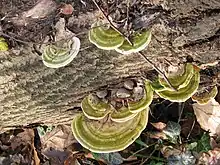Trametes
Trametes is a genus of fungi that is distinguished by a pileate basidiocarp, di- to trimitic hyphal systems, smooth non-dextrinoid spores, and a hymenium usually without true hymenial cystidia.[2] The genus has a widespread distribution and contains about fifty species.[3] The genus was circumscribed by Elias Magnus Fries in 1836.
| Trametes | |
|---|---|
 | |
| Trametes gibbosa | |
| Scientific classification | |
| Domain: | Eukaryota |
| Kingdom: | Fungi |
| Division: | Basidiomycota |
| Class: | Agaricomycetes |
| Order: | Polyporales |
| Family: | Polyporaceae |
| Genus: | Trametes Fr. (1836) |
| Type species | |
| Trametes suaveolens (L.) Fr. (1838) | |
| Synonyms | |
|
Species synonymy[1]
| |
Trametes fungi are food for caterpillars of certain Lepidoptera, mainly fungus moths (Tineidae) such as Triaxomera parasitella.
Biotechnology
Several species of Trametes have been investigated for biotechnological application of their lignin-degrading enzymes (particularly laccase and manganese peroxidase) for analytical, industrial or environmental sciences.[4]
Selected species
- Trametes gibbosa – Lumpy bracket
- Trametes hirsuta – Hairy bracket
- Trametes nivosa
- Trametes pubescens
- Trametes versicolor – Turkey tail
References
- "Trametes Fr". Species Fungorum. Retrieved 2018-07-02.
- Ryvarden L. (1991). "Genera of polypores: Nomenclature and taxonomy." Syn. Fung. 5: 1–363.
- Kirk PM, Cannon PF, Minter DW, Stalpers JA (2008). Dictionary of the Fungi (10th ed.). Wallingford, UK: CAB International. p. 695. ISBN 978-0-85199-826-8.
- Nyanhongo, Gibson F.; Gübitz, Georg; Sukyai, Prakit; Leitner, Christian; Haltrich, Dietmer; Ludwig, Roland (2007). "Oxidoreductases from Trametes spp. in biotechnology: A wealth of catalytic activity". Food Technology and Biotechnology. 45 (3): 250–268.
Further reading
- Zmitrovich I.V., Malysheva V.F. (2013). Towards a phylogeny of Trametes alliance (Basidiomycota, Polyporales). Mikologiya i fitopatologiya. Vol. 47, N 6. P. 358–380 (http://media.wix.com/ugd/b65817_d1162add57d74fe08e46f728018208ac.pdf).
Wikimedia Commons has media related to Trametes.
This article is issued from Wikipedia. The text is licensed under Creative Commons - Attribution - Sharealike. Additional terms may apply for the media files.